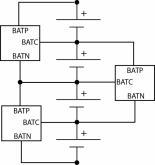Update,
I received a 4s unit and did a preliminary test. It began to sort of work but quickly broke into what appeared as an oscillatory mode.
I checked it on batteries, supercaps, and controlled power supply for one cell location and selected load resistors on other cell location to control voltage across resistor load to less then 0.15v below power supply voltage on other cell location.
I came across a Youtube video of a British guy that seems to demonstrate a stable operation on supercaps. However he did not measure transfer current and was limited by his supercaps to 2.5v max per cell.
(The 3.75v ULVO, Under lock-out voltage threshold, I was worried about turns out to be minimum sum voltage for both cells in series, not single cell)
The ETA3000 specs has several nebulous items in its spec but one very clearly stated item is in the paragraph titled 'Protection' clearly states if either cell drops below V_precond, which is 2.8v, the transfer current drops to 10% of the level set by ISET pin resistors (ISET = 51K -> 1 amp on received board)
So I tried dropping my 4.2v capable supercaps down to 2.5v volt range and things got stable, just like Youtube video, although transfer current was less then 80 mA measured with a hall effect probe.
It appears that either bad PCB layout or resistance of supplied small gauge connector wires is creating a feedback instablity for higher transfer current.
When I get some time, I will try to remove the conformal coating and change the ISET resistors to set a lower transfer current and see if it operates correctly at normal cell voltages.




